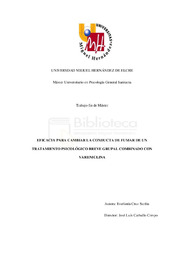Por favor, use este identificador para citar o enlazar este ítem:
https://hdl.handle.net/11000/5972Registro completo de metadatos
| Campo DC | Valor | Lengua/Idioma |
|---|---|---|
| dc.contributor.advisor | Carballo, José Luis | - |
| dc.contributor.author | Cruz Sicilia, Estefanía | - |
| dc.contributor.other | Departamentos de la UMH::Psicología de la Salud | es |
| dc.date.accessioned | 2020-04-23T07:55:03Z | - |
| dc.date.available | 2020-04-23T07:55:03Z | - |
| dc.date.created | 2016-02 | - |
| dc.date.issued | 2020-04-23 | - |
| dc.identifier.uri | http://hdl.handle.net/11000/5972 | - |
| dc.description.abstract | Para comparar la eficacia para cambiar la conducta de fumar de un tratamiento psicológico grupal (Guided Self-Change Treatment Model,GSTM) combinado con terapia farmacológica con Vareniclina (GSTM + TF), frente al tratamiento farmacológico aplicado aisladamente (TF). Se realizó un estudio experimental de medidas repetidas pre y pos-tratamiento y un seguimiento a los 7 meses, con 85 pacientes asignados aleatoriamente a cada una de las dos modalidades de tratamiento, que demandaron asistencia para cambiar su conducta de fumar en el Servicio de Neumología del Hospital General de Alicante. Entre los pacientes que completaron el seguimiento (n=47), el tratamiento GSTM+TF mostró tasas de abstinencia a los 7 meses mayores que la TF, pese a que no resultaron estadísticamente significativas. Se encontraron diferencias estadísticamente significativas en la sintomatología ansiosa a los 7 meses, siendo menor en los pacientes del grupo GSTM+TF. Estos resultados apuntan que el tratamiento farmacológico puede conseguir tasas de abstinencia superiores cuando se aplica de manera combinada con un tratamiento psicológico, además de favorecer a la adhesión al tratamiento y a reducir la sintomatología asociada al proceso de deshabituación tabáquico. | es |
| dc.description.abstract | To compare the effectiveness to change the smoking behaviour of a grupal psychologic treatment (Guided Self-Change Treatment Model, GSTM) mixed with pharmacologic therapy with varenicline (GSTM+TF), opposite to the pharmacologic treatment, applied individually (TF), it was conducted an experimental study of repeated measures pre and post-treatment, and a follow seven months later; with eighty five patients assigned randomly to each one of the two treatment’ modalities, which demanded attendance to change their smoking behaviour in the Pulmonology Department of the Hospital of Alicante. Between the patients who completed the follow (n=47), the treatment GSTM+TF showed abstinence rates at seven months, bigger than the TF, despite they didn’t result statistically significatives. Statistically significative differences were found in the anxiety symptomatology at seven months, being less in the patients of group GSTM+TF. These results point that the pharmacologic treatment can get higher abstinence rates when is applied in combination with a psychological treatment, besidesstimulating the adhesion to the treatment and reducing the symptomatology associated to the detoxification smoking process. | es |
| dc.format | application/pdf | es |
| dc.format.extent | 35 | es |
| dc.language.iso | spa | es |
| dc.rights | info:eu-repo/semantics/openAccess | es |
| dc.subject | diseño | es |
| dc.subject | farmaco | es |
| dc.subject | fumar | es |
| dc.subject | vareniclina | es |
| dc.subject | tratamiento psicológico | es |
| dc.subject.other | CDU::1 - Filosofía y psicología::159.9 - Psicología | es |
| dc.title | Eficacia para cambiar la conducta de fumar de un tratamiento psicológico breve grupal combinado con vareniclina | es |
| dc.type | info:eu-repo/semantics/masterThesis | es |

Ver/Abrir:
CRUZ Estefania TFM .pdf
669,74 kB
Adobe PDF
Compartir:
 La licencia se describe como: Atribución-NonComercial-NoDerivada 4.0 Internacional.
La licencia se describe como: Atribución-NonComercial-NoDerivada 4.0 Internacional.
.png)